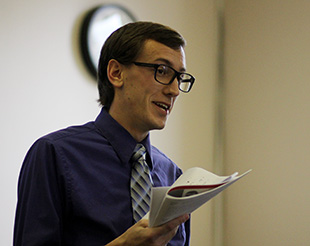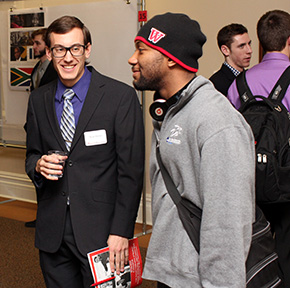Perhaps it was the fact that Ryan Horner ’15 was in the library talking about anything other than comprehensive exams back on Jan. 9 – “definitely more fun than anything else I’m doing right now,” he quipped – but he was engaged and obviously excited about his story by the way he rapped his fingers on the table as he answered questions.
It was a glimmer that turned into something deeper: an image that stuck with him from a family vacation went on to become “It Came Under Some Duress,” his submission for the Celebration of Student Research, Scholarship, and Creative Work. First, he self-imposed a few limitations because, as he put it, “the blank paper was too blank and I could go in a bazillion different directions.”
The story would be limited to 2,000 words, which is on the lean end of the short-story spectrum (2,000-15,000 words), and include at least two, and probably more, perspective changes. There would be two fully imagined female characters with one part of the story taking place under water. Yes, under water.
 The setting is a tiny family-owned marina on a lake where the power is out and the owners, desperate for business, are coming up with ways to keep things afloat.
The setting is a tiny family-owned marina on a lake where the power is out and the owners, desperate for business, are coming up with ways to keep things afloat.
“Over finals week, I remembered one of the funniest, oddest details, which is that we were on a lake in the boat looking for a marina,” Horner said. “We found one, but the power was out. It was eerily quiet. There was something really weird about moving through a marina designed to sell you things and there was nothing they could do about it. We were navigating this dark space.”
The rough draft of the story was almost a thousand words marked up with nearly as many in boldface or followed by “XXXX.” There were parenthetical phrases – (just waiting on a generator part) – and other suggestions. There were questions – how do they respond? – and plot points, lists of characters and wants – “Slightly unlikable immediately” – to go with restrictions and edits.
“HOP RIGHT INTO THE PROBLEM” jumps out at the reader about two-thirds of the way through the draft. It’s here where Horner’s struggle comes though. He’s never been in a situation before with these limitations, and he’s got to get things going rapidly. How are all of these ideas webbed together?
“It’s got to be broad strokes with idiosyncratic details that bring it to life quickly and move it along,” said Horner, a product of Greentown, IN. “I have to change perspectives quickly. I’ve forced the story in a direction and I have to find a way to get things going that way. The reader will have to do some quick thinking, but I can’t leave them out to sea.”
Horner says he was able to edit quickly and keep the story progressing as the Celebration crept closer on the calendar.
“These limits are working pretty well for my brain,” he said, over the sound of his rapping fingers. “The story is moving along, but I’ve x-ed out a lot of possibilities quickly. We’ll know closer to the final product whether or not it was smart. I went from a glimmer to having characters on the page and interacting quickly and well.
“In the future, I’d like to be doing 3,000 word pieces because I like them a lot,” Horner continued. “You read 3,000 words in 10 minutes – you’re hit with a hammer once instead of punched once, kicked once – it’s one broad-stroke blow. Those are the stories I really like reading and I’d like to get to a point where I could write those well.”
Fast forward to Friday’s presentation and Horner is reading his story to a packed room. Every seat is occupied and his cross country teammates fill the back of the room.
He delivered an impactful story that met his criteria, connected with his audience, and elicited some essential feedback.
“I feel better about the story than I did two hours ago,” he said after the reading. “The experience was helpful because I got to hear people and watch as they listened. I was watching the audience quite a bit because you can see when people are hanging on the word of if they are puzzled.”
It wasn’t surprising he got so much from his audience. Those powers of observation and ability to connect are evident to Roger Busch, his cross country coach.
“Ryan is absolutely amazing,” said Busch. “He loves the background work. He likes the fact that over a 15-mile training run, he’s outside, and he gets to see the countryside. He’s usually reading, so it’s nice to say, ‘Hey, put the book down and let’s talk.’”
It’s hard to say which was more meaningful to Horner, presenting “It Came Under Some Duress” to an audience or having them connect with it.
“I had people from all walks of my life, people who I met at work, many cross country guys, and professors that I’ve collaborated with,” he ended. “The coolest thing for me was a very diverse and supportive audience. People sought out the reading. That was an awesome experience.”